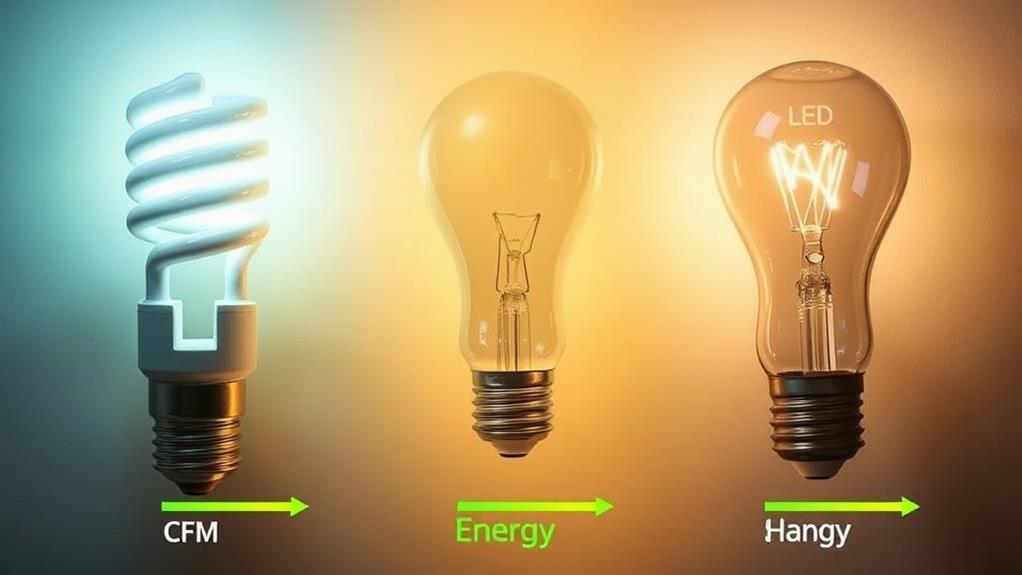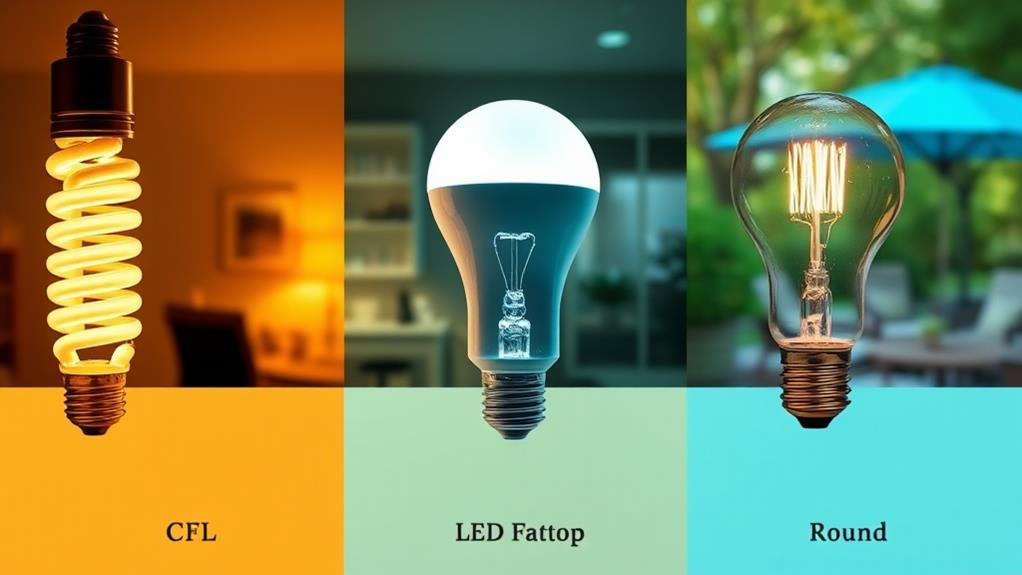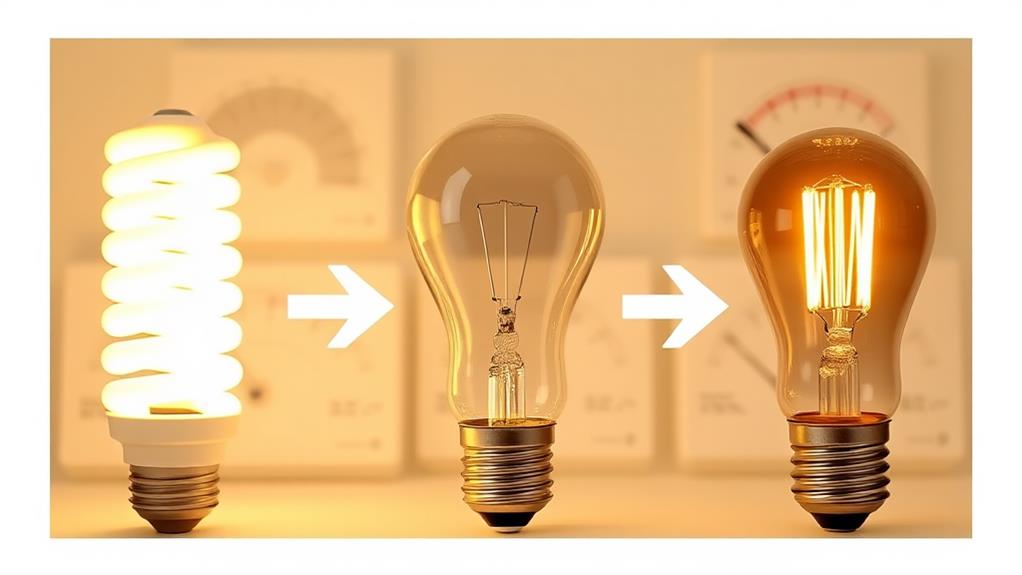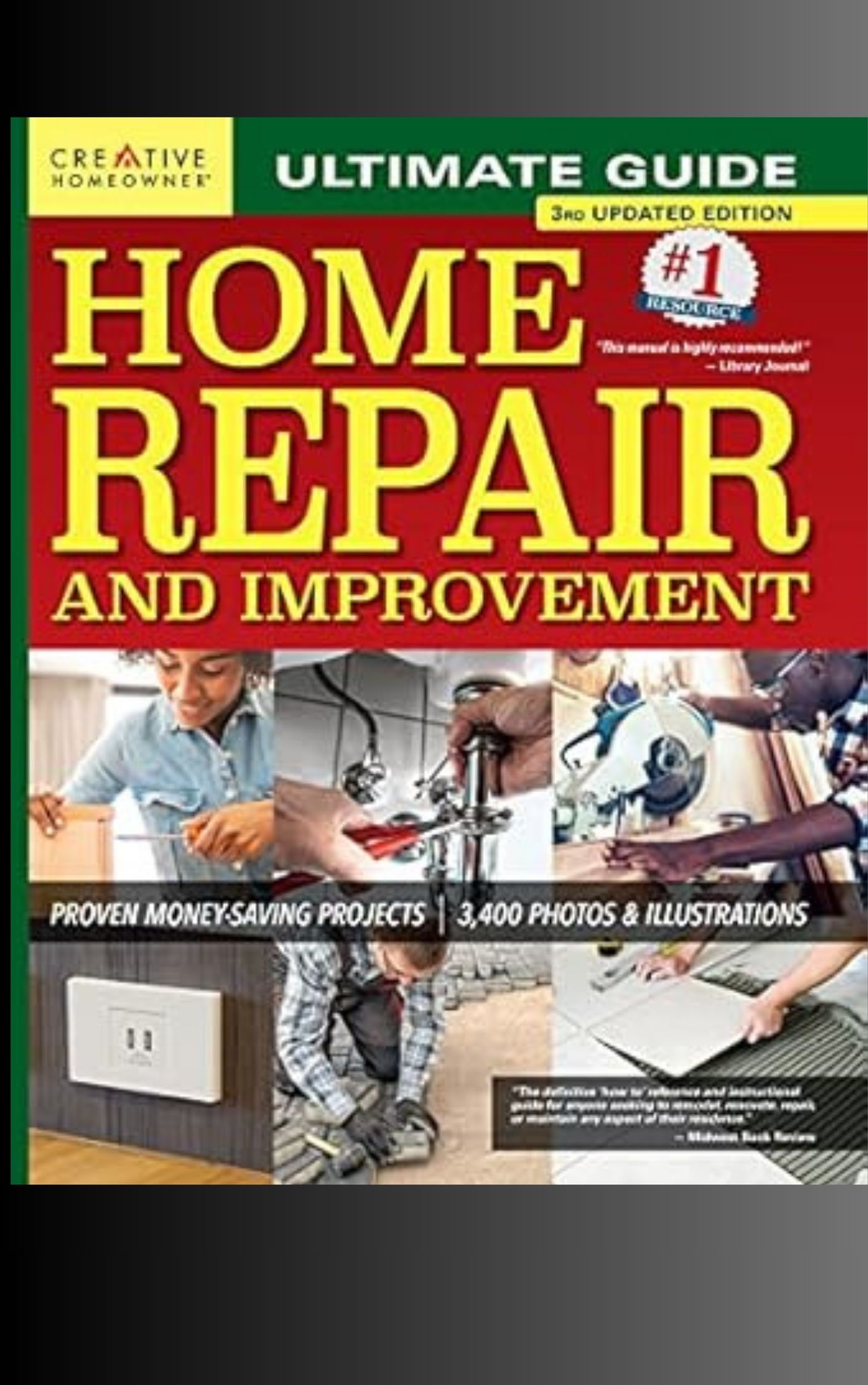When comparing CFL, LED, and incandescent bulbs, you'll find significant differences in energy efficiency, lifespan, and light quality. LEDs are the most energy-efficient, using up to 90% less energy than incandescents, while CFLs use about 75% less. LEDs also last the longest, with a lifespan of 25,000 to 50,000 hours, compared to 8,000-10,000 for CFLs and 750-2,000 for incandescents. Light quality varies, with incandescents offering excellent color rendering, LEDs providing a wide range of options, and CFLs typically producing cooler light. Environmental impact and disposal considerations also differ among the three types. Understanding these factors can help you make the best choice for your lighting needs.
Energy Efficiency and Cost Savings

Nearly all homeowners are looking to save money on their energy bills, and lighting is a great place to start. When comparing CFL, LED, and incandescent bulbs, you'll find significant differences in energy efficiency and cost savings.
Incandescent bulbs are the least efficient option. They convert only 10% of energy into light, wasting the rest as heat. While they're cheap upfront, their short lifespan and high energy consumption make them costly in the long run.
CFLs are more energy-efficient, using about 75% less energy than incandescents. They last longer too, typically 6-15 times more than traditional bulbs. However, they contain small amounts of mercury, requiring careful disposal.
LEDs are the most energy-efficient choice. They use up to 90% less energy than incandescents and last 25 times longer. Although they've a higher initial cost, you'll see substantial savings over time. LEDs don't contain hazardous materials and are available in various colors and brightness levels.
Lifespan and Durability
Longevity is a crucial factor when choosing light bulbs, and it's closely tied to their durability. LED bulbs stand out in this category, typically lasting 25,000 to 50,000 hours. This means you could use an LED bulb for up to 20 years before needing a replacement.
CFLs come in second, with an average lifespan of 8,000 to 10,000 hours, which translates to about 7-9 years of use. In contrast, incandescent bulbs have the shortest lifespan, lasting only 750 to 2,000 hours, or about 1-2 years.
When it comes to durability, LED bulbs again take the lead. They're made with sturdy materials and don't have fragile filaments or glass tubes, making them resistant to breakage and vibrations. CFLs are more durable than incandescent bulbs but can be sensitive to frequent on-off cycles and extreme temperatures. Incandescent bulbs are the most fragile, with thin filaments that can easily break from shocks or vibrations.
You'll find that LED bulbs maintain their brightness throughout their lifespan, while CFLs and incandescent bulbs may dim over time. This consistent performance adds to the overall value and reliability of LED lighting options.
Light Quality and Color Rendering

Light quality and color rendering often play a crucial role in choosing the right bulb for your needs. Incandescent bulbs have long been the standard for warm, natural light with excellent color rendering. They produce a full spectrum of light, making colors appear vibrant and true to life. However, CFLs and LEDs have made significant improvements in this area.
CFLs typically offer a cooler light, which some find less flattering. They've been criticized for their slightly greenish tint and poorer color rendering compared to incandescents. However, newer CFLs come in various color temperatures, allowing you to choose warmer options that more closely mimic incandescent light.
LEDs have made the most progress in light quality. You'll find LEDs in a wide range of color temperatures, from warm white to daylight. Many high-quality LEDs now offer excellent color rendering, rivaling or even surpassing incandescents. Some LED bulbs can even change color or adjust their color temperature, giving you unprecedented control over your lighting environment.
When selecting bulbs, pay attention to the Color Rendering Index (CRI) and color temperature. A higher CRI (90+) indicates better color accuracy, while color temperature (measured in Kelvins) determines whether the light appears warm or cool.
Environmental Impact and Disposal
While light quality and color rendering are important considerations, the environmental impact of different bulb types is equally significant. When choosing between CFL, LED, and incandescent bulbs, you'll want to consider their energy consumption and disposal methods.
Incandescent bulbs are the least energy-efficient, converting only 10% of energy into light and wasting the rest as heat. They don't contain hazardous materials but have a short lifespan, leading to more frequent replacements and waste.
CFLs are more energy-efficient than incandescents but contain small amounts of mercury. You'll need to dispose of them properly at designated recycling centers to prevent environmental contamination. Their lifespan is longer than incandescents, reducing waste over time.
LEDs are the most environmentally friendly option. They're highly energy-efficient, have the longest lifespan, and don't contain hazardous materials. You can dispose of them in regular trash, but recycling is still recommended to recover valuable materials.
When considering disposal, remember that LEDs produce the least waste due to their longevity. CFLs require special handling, while incandescents can be thrown away but contribute more to landfills because of their short lifespan.
Applications and Suitability

Different lighting scenarios call for specific bulb types, each with its own strengths and weaknesses. For general home lighting, LEDs are often the best choice due to their energy efficiency and long lifespan. They're suitable for most fixtures and can provide a range of color temperatures to suit your preferences.
CFLs are a good option for areas where lights are left on for extended periods, like living rooms or kitchens. They're energy-efficient and more affordable than LEDs, but they take time to reach full brightness and aren't ideal for frequent on/off switching.
Incandescent bulbs, while less efficient, still have their place. They're perfect for areas where you need instant, warm light or where dimming is important, such as dining rooms or bedrooms. They're also suitable for specialty applications like oven lights due to their heat resistance.
For outdoor lighting, LEDs are excellent choices as they perform well in cold temperatures and are durable. CFLs can be used outdoors but may take longer to warm up in cold weather. Incandescent bulbs are less suitable for outdoor use due to their shorter lifespan and sensitivity to temperature changes.
Conclusion
You've seen how CFL, LED, and incandescent bulbs stack up. While each has its place, LED technology is pulling ahead like a steam locomotive in the lighting race. They're energy-efficient, long-lasting, and versatile. CFLs offer a middle ground, while incandescents are fading out. Consider your specific needs, from color rendering to environmental impact, when choosing. Ultimately, you'll want to balance cost, efficiency, and light quality to illuminate your space effectively.

